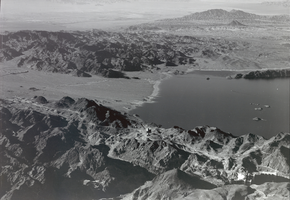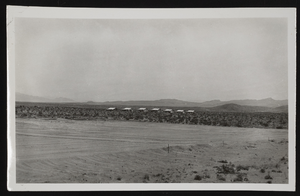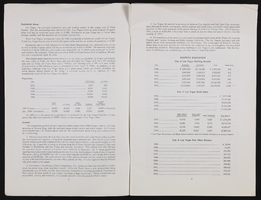Search the Special Collections and Archives Portal
Search Results
Vernon G. Stockall oral history interview
Identifier
Abstract
Oral history interview with Vernon G. Stockall conducted by Aurora Wright on March 07, 1981 for the Ralph Roske Oral History Project on Early Las Vegas. In this interview, Stockall discusses arriving in Boulder City, Nevada in 1935 and describes how the Great Depression caused people to migrate westward. He then recalls working as a pipe fitter at the Hoover Dam (Boulder Dam) and explains the type of work that he did. Lastly, Stockall discusses the growth of Las Vegas, Nevada as the population increased.
Archival Collection

Film transparency showing Lake Mead, circa 1930s
Date
Archival Collection
Description
Image
John P. Watkins oral history interview
Identifier
Abstract
Oral history interview with John P. Watkins conducted by Brian Watkins on March 04, 1979 for the Ralph Roske Oral History Project on Early Las Vegas. In this interview, Watkins discusses his personal history and education in medicine. He then describes being one of the first urologists in Las Vegas, Nevada and recalls his experiences at various hospitals throughout the city. Later, Watkins discusses the first malpractice insurance available and why such insurance was important for private physicians. Lastly, Watkins describes the American Medical Association (AMA), construction of Hoover Dam (Boulder Dam), and the development of casinos on the Las Vegas Strip.
Archival Collection
Juanita Kilburg oral history interview
Identifier
Abstract
Oral history interview with Juanita Kilburg conducted by Vicente Camacho on March 07, 1981 for the Ralph Roske Oral History Project on Early Las Vegas. Kilburg discusses the Boulder (Hoover) Dam, McCarran International Airport, Nellis Air Force Base, living in Las Vegas, Nevada during the Great Depression, and casinos. The interview concludes with a discussion on her work with the American Legion service organization.
Archival Collection
Elton Garrett oral history interviews
Identifier
Abstract
Oral history interviews with Elton Garrett conducted by Dennis McBride on November 10 and 11, 1986 for the Boulder City Library Oral History Project. In these interviews, Garrett talks about hitchhiking into Nevada in 1928, the beginning of his journalism career in 1929, and the development and construction of the Hoover Dam and Boulder City. He relates anecdotes about events and people during this early period and talks about the choice of The Six Companies, Incorporated to build the dam. He continues, talking about the impact of prohibition, bootlegging, and illegal gambling before 1931. Later he talks about his work as an educator in Boulder City, and the decision by the city to work toward self-government and incorporation.
Archival Collection
Lillian and Lloyd Morrison oral history interview
Identifier
Abstract
Oral history interview with Lillian and Lloyd Morrison conducted by Don Morrison on October 20, 1991 for the UNLV Libraries Oral History Collection. The Morrison's talk about the loss of their Iowa farm in the Great Depression and Lloyd's decision to set out for Nevada to seek work at the Hoover dam construction site. He speaks at length about finding work, working on the dam, and an injury suffered in a fall that left him temporarily in a wheelchair. Lillian recalls arriving in Boulder City, Nevada some three years after Lloyd, of various homes the couple and their young son lived in, taking in boarders for extra money, and the growth and contraction of the town's population.
Archival Collection

Transcript of interview with Ray Cutright, April 22, 1981
Date
Archival Collection
Description
On April 22, 1981, Ray Cutright (born 1902 in French Creek, West Virginia) provided brief a narrative-style oral history about his work as a boater in the Colorado River during the building of Hoover Dam. Cutright talks about his experiences in operating a boat that carried both tourist passengers and workers to and from the site of the Hoover Dam. He also provides a few specific experiences, including what it was like navigating the river.
Text

Photograph of housing, Boulder City (Nev.), approximately 1931-1936
Date
Archival Collection
Description
Image
Paul M. Lytle oral history interview
Identifier
Abstract
Oral history interview with Paul M. Lytle conducted by James Greene on December 19, 1974 for the Ralph Roske Oral History Project on Early Las Vegas. In the interview, Lytle discusses moving to Boulder City, Nevada in 1936 to work as a Boulder (Hoover) Dam guide. Lytle also discusses his early life moving around Nevada, his family, his experiences with railroad freight cars, Boulder Highway's road conditions and roadside stores, and his service in the United States Army during World War II.
Archival Collection

